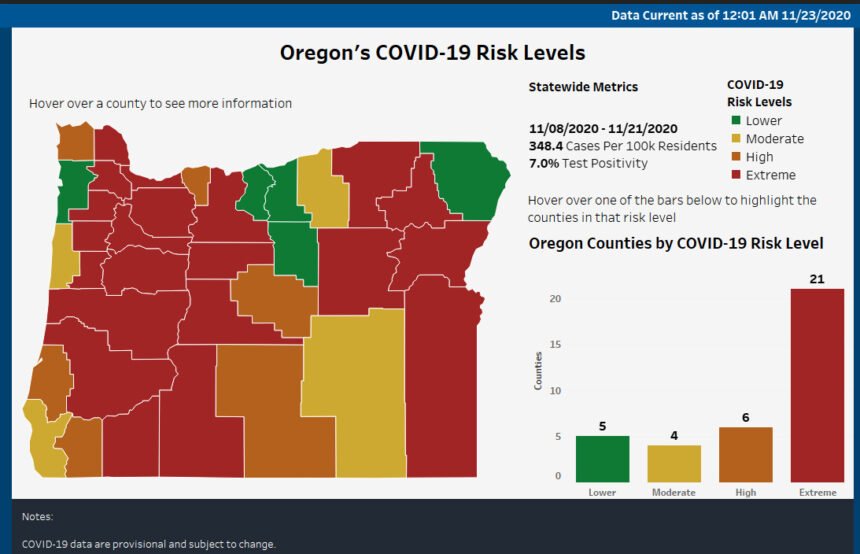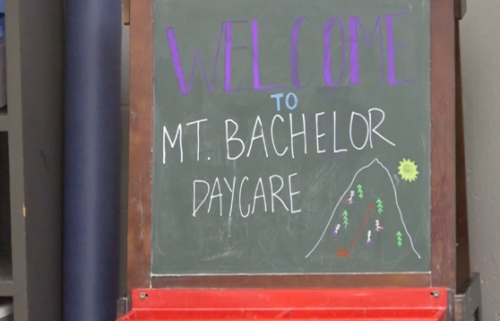Oregon relaxing some restrictions, despite still-high COVID-19 cases

Complex metrics to move into place as freeze ends; Deschutes, Jefferson counties among 21 still in 'extreme risk' category; Crook in 'high'
SALEM, Ore. (AP) — Bars and restaurants can reopen for limited outdoor service next week, but many restrictions will remain in place until a vaccine against the coronavirus is widely available, Oregon Gov. Kate Brown said Wednesday.
At a pre-Thanksgiving news conference, pleaded with Oregonians to stay safe during the holidays, and protect others, by not ignoring safety protocols, like wearing masks and limiting personal contacts.
“Please, please make smart choices this holiday weekend that will protect you, your family and your neighbors,” she told a Zoom news conference. “Irresponsible behavior over Thanksgiving, at best, will only make the pandemic last longer. At worst, it will send one of your loved ones to the ICU.”
State officials also announced vaccines would soon be coming to Oregon, though details remained unclear.
The revamped restrictions to combat the unprecedented rate of COVID-19 infections and hospitalizations take effect when the current two-week “freeze” expires on Dec. 3. Currently, only take-out restaurant service is allowed. The restaurant industry pushed hard against the restrictions as several eateries closed for good and others were at risk of doing so.
Asked if at a virtual news conference if she was bending to industry pressure, Brown said: “I’m in the business, frankly, of saving lives and also preserving livelihoods.”
State officials also said they expect to receive enough doses from the federal government in December to vaccinate 30,000 people, with priority given to health care workers caring for COVID-19 patients.
“Until our COVID-19 vaccines are widely available, health and safety precautions will remain in place so that our schools, our businesses and our communities can reopen and stay open,” Brown said.
Patrick Allen, director of the Oregon Health Authority, or OHA, said details are still muddled.
He told reporters that he spoke on the phone Tuesday with a general from Operation Warp Speed, the federal government’s partnership with private pharmaceutical companies to develop a COVID-19 vaccine.
“There’s still a lot of lack of clarity,” Allen said, adding that Oregon needs more vaccines than are initially coming but he expects the number to increase rapidly, especially if multiple vaccines are distribute.
As of Monday, 21 of Oregon’s 36 counties were designated “extreme risk” because of the numbers of infections. That highest of four risk categories include the counties ones encompassing the Portland metropolitan area, as well as Marion County, Lane County and Deschutes County. Jefferson County is also in the "extreme" category, while Crook County is in the "high" category.
The OHA also reported 1,189 new confirmed and presumptive cases of COVID-19 on Wednesday, bringing the state total to 68,503. Another 20 people in the state have died because of the virus, raising the state’s known death toll to 867.
The number of hospitalized COVID-19 patients across Oregon increased to 489, with 113 in intensive care units. Oregon has a total of 702 adult ICU beds, according to the OHA, and 146 were available as of Wednesday. The current capacity is available at this dashboard.
Officials said more of a concern than lack of hospital beds is that there may not be enough health care workers to handle a great surge in coronavirus infections.
Under the new phases of restrictions, counties at extreme risk could have outdoor dining with maximum 50 capacity. Indoor dining, not to exceed 25% capacity, would be allowed for counties at high risk, and with 50% capacity in counties designated as moderate or lower risk.
State epidemiologist Dean Sidelinger said outdoor dining does not mean eating in a place enclosed by cloth or plastic walls, as some restaurants had erected as the weather turns cold and rainy in much of Oregon. He said a roof is allowed, but three sides should be open, or the risk of infection is as high as dining indoors.
“We must double down on our efforts to keep COVID from spreading,” Brown said. “The situation is extremely dire. … Not everyone dies from COVID-19, that’s true. But trust me, this is a virus you don’t want to get.”
Brown and other health officials, asked by reporters why restrictions were loosened despite the sharp rise in cases, said the sharp restrictions of the two-week freeze are not sustainable long-term, and it was always planned to reduce them to some degree. Oregon Health Authority Director Patrick Allen said the goal was to strike “a necessary balance between precaution and pragmatism.”
Gov. Kate Brown's office news release:
Heading Into the Thanksgiving Holiday, Governor Kate Brown Urges Oregonians to Work Together to Keep Friends and Family Safe from COVID-19
Strict health and safety measures will remain in place in 21 Extreme Risk counties where COVID-19 is widespread and hospitalizations are high
(Salem, OR) — With COVID-19 cases and hospitalizations at an all-time high for the pandemic, Governor Kate Brown today urged Oregonians to remember that the entire state is under a Two-Week Freeze, and to keep their Thanksgiving gatherings small and use precautions to protect themselves and loved ones from the spread of COVID-19. With infection rates surging in Oregon, the Governor also cautioned that strict health and safety measures will likely need to remain in place for at least 21 counties found to be at extreme risk for COVID-19 spread following the Two-Week Freeze, which ends on December 2.
“It’s been a long year — and one that has been exceptionally challenging for Oregonians,” said Governor Brown. “Not only have we been dealing with this pandemic, we also suffered through a heartbreaking and historic wildfire season. So many families have lost so much this year. Unfortunately, now, more than ever, is the time we must double down on our efforts to stop COVID from spreading.
“When people don’t respect how serious this virus is, and when they act against the recommendations of doctors and public health experts, not only are they putting themselves at risk, they’re putting all of us at risk. Making smart choices — to wear a mask, to limit your social gatherings, to stay home when sick — will get us out of this horrible situation faster, and bring us closer to normal life, closer to reopening our businesses and keeping them open, and closer to getting our kids back in the classroom.”
As the pandemic continues into the winter months, when cases are expected to continue to rise, the Governor announced a new health and safety framework, with four different risk levels for counties based on their level of COVID-19 spread, to take effect after the Two-Week Freeze ends on December 2. At each risk level — Extreme Risk, High Risk, Moderate Risk, and Lower Risk — health and safety measures and guidance for businesses and individuals will apply. The framework is intended to establish sustainable protection measures for Oregonians in counties with rapid spread of COVID-19, while balancing the economic needs of families and businesses in the absence of a federal aid package.
Click here for a list of counties in each risk level using data available as of November 23.
On Monday, November 30, the Oregon Health Authority will reexamine county data to determine which counties qualify for each risk level on December 3, following the end of the 2-Week Freeze. In each subsequent two-week period, the Oregon Health Authority will examine and publish county data weekly, but county risk levels will not change until the end of the second week. In the first week, counties will be given Warning Week data to prepare for potential risk level changes. In the second week, county risk levels will be updated based on that week’s data.
In counties with extreme risk, the following activities will be allowed, with health and safety protocols in place:
- Social and at-home gatherings with people from outside your household will be limited to a maximum of six people, with a recommended limit of two households.
- Restaurants, bars, and other eating and drinking establishments will be limited to a maximum of 50 people for outdoor dining only, with only six people per table. Take-out is strongly encouraged.
- Indoor recreation, fitness, and entertainment establishments, including gyms, will remain closed, however, outdoor recreation, fitness, and entertainment activities, including outdoor gym activities, will be allowed, with a maximum limit of 50 people outdoors.
- Retail stores, grocery stores, pharmacies, and indoor and outdoor shopping centers and malls will be limited to a maximum of 50% of capacity, with curbside pick-up encouraged.
- Faith institutions, funeral homes, mortuaries, and cemeteries will be limited to a maximum of 25% of capacity or 100 people indoors (whichever is smaller), or 150 people outdoors.
- Office workplaces will be required to utilize remote work to the maximum extent possible, with public-facing offices closed to the public.
- Personal services businesses will be allowed to continue to operate with health and safety measures in place.
- Long-term care facilities can allow limited outdoor visitation, following established health and safety protocols.
Oregon counties that are successful in reducing their COVID-19 risk levels in the coming weeks and months will be able to incrementally move to lower risk levels.
It’s important to note that there is no Zero Risk category. Until COVID-19 vaccines are widely available, health and safety precautions will remain in place so that schools, businesses, and communities can reopen, and stay open. At every risk level, to prevent COVID-19 outbreaks, Oregonians must continue to wear face coverings, watch their physical distance, wash hands, stay home when sick, and keep social get-togethers and gatherings small.
More information on the county risk level framework is available here:
Disease Spread Table
County Risk Level Table
Guidance by Activity
Map of County Risk Levels as of 11/23/20
More information will be posted to coronavirus.oregon.gov prior to December 3.
School metrics for K-12 schools and health and safety guidance for child care remain unchanged under this framework.



